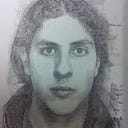Editing a Texture File to Create an Emission map with GIMP
Emission is seen as a source of light in a game object. Examples of emissive materials are the screen of a computer turned on, corridor lights, and any object that looks lit up from the inside out. This feature gives a great tone to scenes, as it works separately from the types of lights given in Unity.
To achieve this, the shader material asks for an alpha texture that blends along the Albedo texture. This is a light layer that tells Unity which parts of the texture map have light and what shouldn’t be emissive.
Let’s take our Albedo used as Base Channel:
Let’s identify the emissive areas to be lit up for the columns:
Inside GIMP, add another layer on top of this image, select the emissive areas with a rectangular tool and paint that area white. By doing an Invert Selection, the rest of the image will be selected and that area can be painted black to call out the areas that should not be emissive. The result should look like this.
Once this image is added in the inspector, under the Emission section inside the object’s material, we can toggle it’s property to quickly notice the difference of this material in a dark environment.
Another great thing about using GIMP to edit texture images when creatigin emissive channels is that the design is easily modify to meet a project’s need.
For example, this next asset is used repeatedly and in different ways through out the level. It has two long lines and a wider rectangle of a different color as the background. I use this tile in the map vertically and rotated as a rhombus. When lined straight, the lines might work and align nicely, but when the same tile is used as a rhombus, it feels odd to see those elements diagonally.
To change this asset’s emissive property, let’s identify it in the Base Map:
At the bottom, right, next to the gray square, we can find the square that has the same two long lines and short, fat rectangle. That is the only area that will be emissive in this map for now. To give this squared section a nice touch that will fit around the map and with the object rotated in any direction, I will also add a circle at the center that will be dark, giving a nice contrast to the emissive map.
This is the final result:
This is a nice way to personalize assets and create fine lights for a scene.
